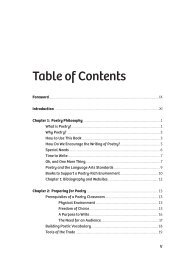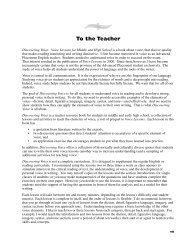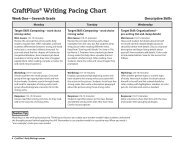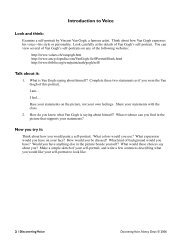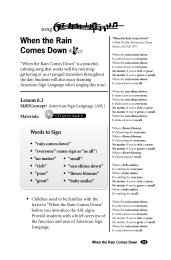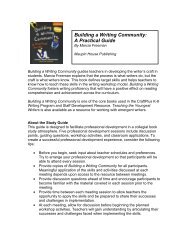literacy resources for Pre-K-12 educators - Maupin House Publishing
literacy resources for Pre-K-12 educators - Maupin House Publishing
literacy resources for Pre-K-12 educators - Maupin House Publishing
You also want an ePaper? Increase the reach of your titles
YUMPU automatically turns print PDFs into web optimized ePapers that Google loves.
Student Engagement is FUNdamental<br />
Building a Learning Community with Hands-on Activities<br />
JANE FEBER (Grades 4-10)<br />
New Titles<br />
Feber’s newest off ering in her award-winning, hands-on approach to<br />
learning gives you ready-to-go activities that engage all learners and add<br />
academic muscle to your curriculum. These classroom-proven activities<br />
are fun, aligned to Common Core Standards, and fl exible enough to fi t<br />
easily into any teaching day and curriculum. Inexpensive, commonly found<br />
supplies become powerful learning tools that build rapport and academic<br />
skills across the curriculum. RTI Tier 2 support<br />
978-1-936700-47-9 | <strong>12</strong>8 pp. | MH # 235 | $19.95<br />
E-BOOK: 978-1-936700-48-6 | MH # 235E | $17.95<br />
Guided Highlighted Reading<br />
A Close-reading Strategy <strong>for</strong> Navigating Complex Text<br />
ELAINE M. WEBER, BARBARA A. NELSON, &<br />
CYNTHIA LYNN SCHOFIELD (Grades 4-<strong>12</strong>)<br />
Common Core Standards now challenge teachers to expose every student<br />
to complex and diffi cult text. Guided Highlighted Reading provides the key,<br />
text-based reading strategy that enables teachers in grades four through<br />
twelve to meet that challenge, with scaff olding <strong>for</strong> four reading purposes:<br />
comprehension, vocabulary, writer’s craft and structure, and preparation<br />
<strong>for</strong> high-stakes, multiple-choice assessments. The authors explain the easy<br />
and eff ective strategy, and they include reproducible reading passage samples from Appendix B of the<br />
Common Core Standards with the prompts that lead students back into the text to fi nd evidence <strong>for</strong><br />
their responses. Includes rubrics. RTI Tier 2 support<br />
978-1-936700-53-0 | <strong>12</strong>8 pp. | MH# 239 | $23.95<br />
E-BOOK: 978-1-936700-54-7 | MH# 239E | $19.95<br />
Available March 20<strong>12</strong><br />
54<br />
Read! Chant! Learn!<br />
60 Literacy-building Chants <strong>for</strong> the K-1 Day<br />
SUSAN NATIONS, SUZI BOYETT, &<br />
KRISTIN BOERGER (Grades K-1)<br />
1<strong>12</strong><br />
Reading Buddies<br />
Reading buddies<br />
can help me read.<br />
I’ll read to you and<br />
you read to me!<br />
Oral Language: Read the poem and have the children listen. Discuss strategies<br />
that good readers use when they read. Have children practice reading a small book<br />
with a reading buddy. Remind them that readers try to use their strategies and listeners<br />
only coach when necessary. The goal of reading buddies is to help children use the<br />
following prompts with each other: “What can you try?” “What looks right?” “What<br />
sounds right?” “What makes sense?” “Try that again.”<br />
Phonics/Phonemic Awareness: Post an enlarged copy of the poem <strong>for</strong> all children<br />
to see. Tell them they are going on a letter hunt <strong>for</strong> the letter “d.” Read the poem slowly<br />
and have them listen <strong>for</strong> the /d/ sound. Select children to come to the front of the group<br />
and point to a letter “d” in the chant. They should tell whether the /d/ sound is in the<br />
middle or end of the word.<br />
Fluency: Provide small copies of the chant in your classroom library or guided reading<br />
area. When students are ready to read with a buddy, have them read this chant together<br />
first. They may want to read it be<strong>for</strong>e and after reading a shared book together.<br />
Vocabulary: Write or highlight the word “help” on a chart or the board. Ask students<br />
to talk about what this means. Remind students that there are many ways that they can<br />
help each other. Reading is only one way to help. Write the word “Help” at the top of<br />
a chart. Let students dictate sentences that tell how we help one another at school.<br />
Comprehension: As a follow-up to the vocabulary activity above, have each child<br />
draw a picture showing how he or she helps others in the classroom. Students can draw<br />
on index cards or large sticky notes to be added to the class-made chart. To label the<br />
pictures, provide a sentence stem such as “I help my buddy by ____________.”<br />
Read! Chant! Learn! 60 Literacy-Building Chants <strong>for</strong> the K-1 Day<br />
Reading Buddies<br />
Reading buddies<br />
can can help help me me read. read.<br />
I’ll I’ll read read to to you you and and<br />
you read to me!<br />
Read! Chant! Learn! 60 Literacy-Building Chants <strong>for</strong> the K-1 Day 113<br />
Develop oral language skills in meaningful and fun ways while building classroom routines. Use<br />
these 60 chants in any order to fi t your classroom needs, facilitate meetings, enhance shared<br />
<strong>literacy</strong> experiences, and transition through the day and year. Activities <strong>for</strong> each chant focus<br />
on the essential fi ve elements of reading instruction—phonics, phonemic awareness, fl uency,<br />
vocabulary, and comprehension—and allow students to revisit known text again and again in<br />
multiple ways. Full-color pages make great posters <strong>for</strong> your classroom. RTI Tier 2 support<br />
978-1-934338-33-9 | 158 pp. | MH # 113E | $19.95<br />
Shop online 24 hours a day at www.maupinhouse.com 5



